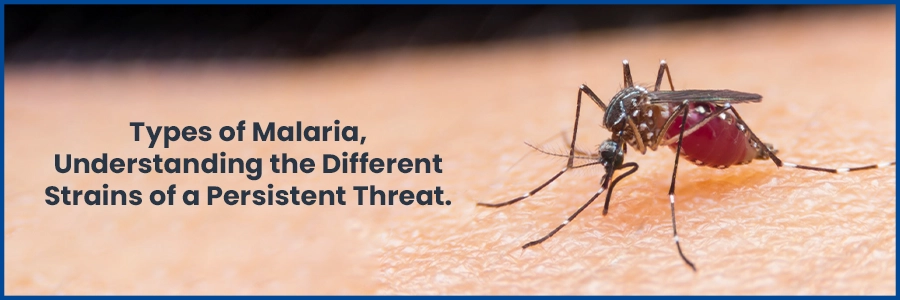- Cardiology 84
- Dermatology 45
- Endocrinology 33
- ENT 16
- Fertility 190
- Gastroenterology 78
- General-Medicine 81
- Gynecology 80
- Hematology 19
- Infectious-Diseases 33
- Neurology 52
- Oncology 34
- Ophthalmology 23
- Orthopedics 69
- Pediatrics 31
- Procedure 23
- Public-Health 144
- Pulmonology 59
- Radiology 8
- Urology 68
- Wellness 161
- Woman-and-child 77

Understanding Malaria Disease and Its Types
Malaria is a life-threatening disease caused by parasites of the Plasmodium genus, transmitted to humans through the bites of infected female Anopheles mosquitoes. Five species of Plasmodium can infect humans, with Plasmodium falciparum and Plasmodium vivax being the most common.
Secure your health with a second opinion. Make informed decisions and book your appointment today!
Get A Second OpinionDifferent Types of Malaria
- Countless individuals globally, particularly in tropical and subtropical areas, are affected by malaria - a life-threatening mosquito-borne disease.
- The Plasmodium parasite causes it and can manifest in various forms, known as types of malaria.
- Understanding these different strains is crucial for effective diagnosis, treatment, and prevention. Throughout this blog, we will deliver the various types of malaria and their distinctive features.
Sub-Types of Plasmodium Parasites
Plasmodium falciparum
- Description: The most dangerous and prevalent kind of malaria.
- Impact: Responsible for the majority of malaria-related deaths globally.
- Symptoms: Rapid replication in red blood cells leads to high fever, anemia, and organ failure.
- Treatment: Timely diagnosis and treatment are crucial to prevent severe complications.
Plasmodium vivax
- Description: The second most common type of malaria is widely distributed across various regions.
- Impact: Can lie dormant in the liver and reactivate in the bloodstream, causing recurrent fever episodes.
- Symptoms: This causes substantial discomfort and can contribute to anaemia and other health complications, though it is usually not as severe as P. falciparum.
Plasmodium ovale
- Description: Less common but similar to P. vivax in its ability to produce relapses.
- Impact: Remains in the liver, leading to recurrent malaria episodes.
- Symptoms: Requires medical attention for proper management, though not as severe as P. falciparum.
Plasmodium Malaria
- Description: Known for its slow replication rate.
- Impact: Causes milder but persistent symptoms and can remain in the body for several years, leading to chronic infection.
- Symptoms: Can contribute to kidney damage if left untreated.
Plasmodium
- Description: Primarily found in Southeast Asia, transmitted from monkeys to humans through mosquito bites.
- Impact: This can lead to severe malaria, resembling P. falciparum infections.
- Symptoms: Requires prompt medical attention due to its severity.
Ready to take control of your health journey? Book your appointment now and start your path towards wellness today!
Book an AppointmentConclusion
Recognizing the different types of malaria is crucial for healthcare professionals in providing appropriate treatment and care. Timely detection, immediate medical care, and preventive actions like mosquito control and bed net usage are vital in reducing malaria-related illnesses and fatalities.
Frequently Asked Questions
The most dangerous type of malaria is caused by the parasite Plasmodium falciparum. It leads to severe symptoms like high fever, anemia, organ failure, and can be life-threatening.
No, malaria caused by one type of parasite cannot change into another type within the same person. Each type is caused by a specific parasite species.
Yes, pregnant women and young children are more vulnerable to severe malaria, especially from Plasmodium falciparum. It can lead to complications for both the mother and child.
Symptoms vary for each type of malaria, but they generally include fever, chills, and flu-like symptoms. Severe cases may involve complications affecting different organs.
Type 2 malaria refers to infections caused by Plasmodium ovale, which can remain dormant in the body for years after initial infection, particularly in West Africa.
In India, Plasmodium vivax is the most common type of malaria. Plasmodium falciparum is also prevalent in certain regions, especially in northeastern states and parts of central India.
Yes, there is a malaria vaccine called RTS,S/AS01, known commercially as Mosquirix. It has been approved for use by the World Health Organization and some national regulatory authorities.

- Cardiology 2132
- Dermatology 168
- Endocrinology 135
- ENT 97
- Fertility 217
- Gastroenterology 232
- General 478
- General-Medicine 1685
- Gynecology 169
- Hematology 85
- Infectious-Diseases 208
- Neurology 207
- Oncology 345
- Ophthalmology 65
- Orthopedics 187
- Pediatrics 83
- Procedure 72
- Public-Health 209
- Pulmonology 126
- Radiology 13
- Second Opinion 311
- Urology 294
- Wellness 600
- Woman-and-child 447
Related Blogs
If you have any questions, please fill out the enquiry form or call us, and we will get back to you promptly.
040-68334455